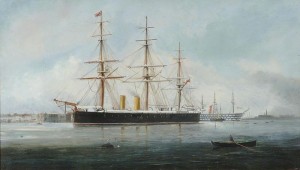DISCLAIMER: I of course realize that the Dystopian Wars setting is intended to be fanciful. The goal of this article is not to prove or disprove the historical accuracy of the game, but rather to give some interesting perspective on the state of naval technology in our time line as compared to the Dystopian Wars one.
Welcome! This is the first of what will hopefully become a series of articles discussing the naval technology portrayed in the game Dystopian Wars by Spartan Games. In this installment, I want to give a brief review of the state of the art in naval technology in our 1870. The latter half of our 19th century was a time of great change for the navies of the world. Two principle innovations were beginning to make their presence felt in a large way: steam power and armor plating.
Steam propulsion was nothing new by 1870; small steam powered craft had been plying the rivers and lakes of both the US and Europe for decades. However, steam propulsion was as yet too unreliable and inefficient to be relied upon as the sole source of propulsion for an ocean-going vessel. This was an especially important consideration for a warship that might have to travel thousands of miles and then face combat at its destination! So, the solution was a hybrid propulsion system (more than a century before the first Prius) that combined steam and sail. Truth be told, though, for many vessels in 1870 sail was still very much the primary mode, with steam serving as the back-up to aid in tactical maneuvering and when winds were unfavorable.
Adding armor plating to warships was a newer innovation, with the first armored warships (referred to as “ironclads”) appearing only in the late 1850s. However, this innovation occurred just in time for the American Civil War, and as so often happens warfare led to rapid technological evolution in iron clad design. During the Civil War, Northern and Southern ironclads clashed with each other and older wooden warships on multiple occasions, most famously in Hampton Roads, VA when the USS Monitor and CSS Virginia fought to a stalemate. Thus, by 1870, un-armored wooden hulled warships were considered completely obsolete.
Along with steam propulsion and armor plating, the turret was also causing major changes to the way warships were armed. The aforementioned USS Monitor was the first warship to successfully employ a turret, and the many monitor-type ironclads built during the Civil War continued the trend. However, these monitors were primarily intended for combat in harbors and rivers. It proved difficult to mount a heavy turret onto a sea-going vessel, especially if that vessel was designed to carry sails. Turrets on these ships were often limited to firing on either broadside, which was only marginally more flexible than the fixed broadside mounts they replaced.
Well, that about wraps up part one. Next time, I’ll briefly recap the development of big-gun ships up through World War I, and then relate that back to the designs we see in Dystopian Wars. Until then!

